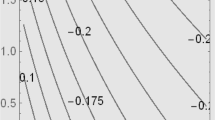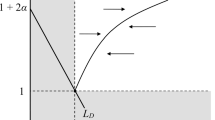Abstract
In this paper, I develop a differential insider–outsider game in which a union of corporative incumbents chooses the wage of its members by taking into account the optimal employment policy of a firm that, in turn, is assumed to decide the number of outsiders to hire in a spot labour market. Under the assumption that incumbents cannot be fired and commit themselves to a given path of wages, I demonstrate that such a game displays an open-loop Stackelberg equilibrium in which the initial stock of insiders pins down the trajectories of incumbents, entrants and insider wages. Moreover, resorting to numerical simulations, I show that adjustments towards the steady-state equilibrium occur through asymmetric oscillations that mimic the decline of union membership and union wage premia observed in the US all over the last 20 years. In addition, I show that the model provides a positive relationship between the labour market power of the insider union and the impatience of the firm.



Similar content being viewed by others
Notes
In the same years, other prominent authors contributed to that theory. For example, Carruth and Oswald (1987) provided a model of union behaviour grounded on the distinction between insider and outsider workers and discussed some related macroeconomic implications such as the possibility that productivity improvements can feed into pure wage increases for insiders with no, or minor, effects on employment. Furthermore, Blanchard and Summers (1986) as well as Gottfries and Horn (1987) relied on insider–outsider relations to explain the strong persistence of unemployment observed in European countries during the 1980s.
Recognizing the inherent dynamic of the insider–outsider hypothesis, a similar exercise is carried out by Vetter and Andersen (1994).
In Morin (2017), union members are either employed or unemployed. When contracting the wage, however, the union considers only the surplus of employed workers because their fallback utility is assumed to coincide with the welfare of unemployed individuals. Therefore, similarly to Huizinga and Schiantarelli (1992), the bargaining process proceeds by weighting the surplus of insiders and the one of the firm.
An alternative hypothesis could be to assume that workers who do not become unionized remain employed without the benefits of union membership. The exploration of that assumption under which outsiders become a distinct state variable in addition to the stock of insiders is left to future developments.
The only thing to notice about Proposition 2 is that when the union does not care about its membership, i.e. when \(\beta \rightarrow 0\), the stationary solution for the insider wage cannot be determined.
Along these lines, it is worth noting that higher (lower) values of m lead to an increase (reduction) of the equilibrium unionization rate.
The quadratic production function of the firm and the log-linear preferences of the union rule out the possibility of limit cycles.
A similar value for the discount rate is also used in the continuous-time union model set forth by Alvarez and Shimer (2014).
To have a trajectory for \(w_{\text {I}}\left( t\right) \) with positive values only, \(D_{a}\) and \(D_{b}\) are fixed to meet the transversality condition in Eq. (17) in a negative neighbourhood of 0.
References
Ackerberg DA, Caves K, Frazer G (2015) Identification properties of recent production function estimators. Econometrica 83(6):2411–2451
Alvarez F, Shimer R (2014) Unions and unemployment. mimeo
Barron JM, Bishop J, Dunkelberg WC (1985) Employer search: the interviewing and hiring of new employees. Rev Econ Stat 67(1):43–52
Becker GS (1983) A theory of competition among pressure groups for political influence. Quart J Econ 98(3):371–400
Begg DKH, Lindbeck A, Martin C, Snower DJ (1989) Symmetric and asymmetric persistence of labor market shocks. J Jpn Int Econ 3(4):554–577
Begg DKH (1988) Hysteresis, market forces, and the role of policy in a dynamic game with insiders and outsiders. Oxford Econ Papers 40(4):587–609
Bertola G (1992) Labor turnover costs and average labor demand. J Labor Econ 10(4):389–411
Binmore K, Rubinstein A, Wolinsky A (1986) The nash bargaining solution in economic modelling. RAND J Econ 17(2):176–188
Blanchflower DG, Bryson A (2004) The Union Wage Premium in the US and the UK. CEP Discussion Paper, No. 612
Blanchard O, Summers L (1986) Hysteresis and the European unemployment problem. In: NBER Macroeconomics Annual, Vol. 1. MIT Press, Cambridge, pp 15–77
Booth A (1984) A public choice model of trade union behaviour and membership. Econ J 94(376):883–898
Carruth AA, Oswald AJ (1987) On union preference and labour market models: insiders and outsiders. Econ J 97(386):431–445
Coe DT, Snower DJ (1997) Policy complementarities: the case for fundamental labor market reform. Staff Paper Int Monet Found 44(1):1–35
Cole HL, Rogerson R (1999) Can the Mortensen–Pissarides matching model match the business cycle? Int Econ Rev 40(4):933–959
Cooper R, Willis JL (2009) The cost of labor adjustment: inferences from the gap. Rev Econ Dyn 12(4):632–647
Delacroix A (2006) A multisectorial matching model of unions. J Monet Econ 53(3):573–596
Dertouzos JN, Pencavel JH (1981) Wage and employment determination under trade unionism: the international typographical union. J Polit Econ 89(6):1162–1181
Dockner EJ, Jorgensen S, Long NV, Sorger G (2000) Differential games in economics and management sciences. Cambridge University Press, New York
Dockner EJ, Feichtinger G (1991) On the optimality of limit cycles in dynamic economic games. J Econ 53(1):31–50
Dockner EJ (1985) Local stability analysis in optimal control problems with two state variables. In: Feichtinger G (ed) Optimal control theory and economic analysis 2. North-Holland, Amsterdam, pp 89–103
Dosi G, Virgillito ME (2019) Whither the evolution of the contemporary social fabric? New Technologies and Old Socio-Economic Trends. LEM Papers Series, No. 2019/02
Drazen A, Gottfries N (1990) The persistence of unemployment in a dynamic insider–outsider model. In: Weiss Y, Fishelson G (eds) Advances in the theory and measurement of unemployment. Palgrave Macmillan, New York, pp 323–335
Farber HS (1987) The analysis of union behavior. In: Ashenfelter O, Layard R (eds) Handbook of labor economics, vol 2, no 2, pp 1039–1089
Fukuda S, Owen RF (2008) Human capital and economic growth: dynamic implications of insider-outsider problem for macroeconomics. Public Policy Rev 4(1):133–158
Gahan PG (2002) (What) do unions maximize? Evid Surv Data Cambridge J Econ 26(3):279–298
Gali J (2016) Insider–outsider labor markets, hysteresis and monetary policy. Working paper of the department of economics and business, Universitat Pompeu Fabra, No. 1506
Giammarioli N (2003) Indeterminacy and search theory. European Central Bank Working Paper Series, No. 271
Gottfries N, Horn H (1987) Wage formation and the persistence of unemployment. Econ J 97(388):877–884
Guerrazzi M (2011) Wage bargaining as an optimal control problem: a dynamic version of the right-to-manage model. In: Optimal control applications and methods, vol 32, pp 609–622
Guerrazzi M, Ksebi I (2019) Measuring unemployment by means of official data and administrative records. Quaderni di Economia del Lavoro—Labour Economics Papers (forthcoming)
Hamermesh DS (1995) Labour demand and the source of adjustment costs. Econ J 105(430):620–634
Hirsh BT, Macpherson DA (2016) Union membership and coverage database from the current population survey. Available at www.unionstats.com
Huizinga F, Schiantarelli F (1992) Dynamics and asymmetric adjustment in insider–outsider models. Econ J 102(415):1451–1466
Jones SRG, McKenna CJ (1994) A dynamic model of union membership and employment. Economica 61(242):179–189
Kaufman BE (2002) Models of union wage determination: what have we learned since dunlop and ross. Ind Relat 41(1):110–158
Kempt MC, Long NV, Shimomura K (1980) Cyclical and noncyclical redistributive taxation. Int Econ Rev 34(2):415–430
Krusell P, Rudanko L (2016) Unions in a frictional labor market. J Monet Econ 80(2):35–50
Kugler AD, Saint-Paul G (2000) Hiring and firing costs, adverse selection and long-term unemployment. IZA Discussion Paper, No. 134
Kydland FE, Prescott EC (1982) Time to build and aggregate fluctuations. Econometrica 50(6):1345–1370
Lindbeck A, Snower DJ (2002) The insider–outsider theory: a survey. IZA Discussion Paper, No. 534
Lindbeck A, Snower DJ (1989) The insider–outsider theory of employment and unemployment. MIT Press, Cambridge
Lindbeck A, Snower DJ (1988) Cooperation, harassment, and involuntary unemployment. Am Econ Rev 78(1):167–188
Lindbeck A, Snower DJ (1987) Efficiency wages versus insiders and outsiders. Eur Econ Rev 31(1–2):407–416
Lindbeck A, Snower DJ (1984) Involuntary unemployment as an insider–outsider dilemma. Seminar paper of the institute for international economic studies, No. 282
Long NV (1992) Pollution control: a differential game approach. Ann Oper Res 37(1):283–296
Manzini P, Snower DJ (2002) Wage determination and the sources of bargaining power. IZA Discussion Paper, No. 535
McCausland WD (1998) Employment hysteresis in an overlapping-generations insider–outsider model. Aust Econ Papers 37(4):394–403
Mattesini F, Rossi L (2009) Optimal monetary policy in economies with dual labor market. J Econ Dyn Control 33(7):1469–1489
Mattesini F, Rossi L (2008) Productivity shocks and optimal monetary policy in a unionized labor market economy. Manchest School 76(5):578–611
Morin A (2017) Cyclicality of wages and union power. Lab Econ 48(7):1–22
Nair-Reichert U (2000) R&D investment and import competition in unionized industries. Appl Econ Lett 8(10):669–674
Oi WY (1962) Labor as a quasi-fixed factor. J Polit Econ 70(6):538–555
Osborne MJ, Rubinstein A (1990) Bargaining and markets. Academic Press, London
Pencavel JH (1985) Wages and employment under trade unionism: microeconomic models and macroeconomic applications. Scand J Econ 87(2):197–225
Sanfey PJ (1995) Insider and outsiders in union models. J Econ Surveys 9(3):255–284
Shimer R (2005) The cyclical behavior of equilibrium unemployment and vacancies. Am Econ Rev 95(1):25–48
Solow RM (1985) Insiders and outsiders in wage determination. Scand J Econ 87(2):411–428
Stemp PJ, Herbert RC (2006) Solving non-linear models with saddle path instability. Comput Econ 28(2):211–231
Trigari A (2006) The role of search frictions and bargaining for inflation dynamics. IGIER Working Paper, No. 304
van Vliet O, Caminada K (2012) Unemployment replacement rates dataset among 34 welfare states: 1971–2009. Neujobs Report, No. 2
Vetter H, Andersen TM (1994) Do turnover costs protect insiders? Econ J 104(442):124–130
Zanetti F (2007) A non-Walrasian labor market in a monetary model of the business cycle. J Econ Dyn Control 31(7):2413–2437
Zanetti F (2006) Labor market frictions, indeterminacy, and interest rate rules. J Money Credit Bank 38(7):1959–1970
Author information
Authors and Affiliations
Corresponding author
Ethics declarations
Conflict of interest
The corresponding author states that there is no conflict of interest.
Additional information
Publisher's Note
Springer Nature remains neutral with regard to jurisdictional claims in published maps and institutional affiliations.
The author would like to thank the participants from the 10th NED Conference (Pisa, 2017) for their helpful comments and suggestions on a previous draft of the paper. The author also thank two anonymous referees of this journal for their insightful and encouraging comments. The usual disclaimers apply.
Electronic supplementary material
Below is the link to the electronic supplementary material.
Appendix: Controllability of the firm problem
Appendix: Controllability of the firm problem
Consider the first two differential equations of the dynamic system in (14). They read as
Taking into account Eq. (10), the system of autonomous differential equations in (A.1) can be written as the following linear time-invariant (LTI) system that describes the solution of the firm problem:
where \(w_{\text {I}}\left( t\right) \) is the control of the union.
The controllability matrix of the LTI system in (A.2) is given by
Since H has full rank, i.e. \(rank\left( H\right) =2\), the problem of the firm is controllable by the union.
About this article
Cite this article
Guerrazzi, M. Wage and employment determination in a dynamic insider–outsider model. Evolut Inst Econ Rev 17, 1–23 (2020). https://doi.org/10.1007/s40844-019-00158-w
Published:
Issue Date:
DOI: https://doi.org/10.1007/s40844-019-00158-w




